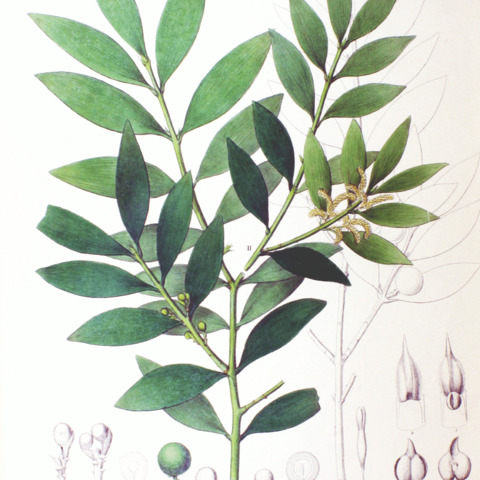Trees or shrubs to 20 m tall; trunk to 50 cm d.b.h.; bark reddish brown, dark purplish red, or light or dark gray, peeling in small, thin flakes; branches and branchlets erect, ascending, spreading, or ± pendulous, grayish to dark brown, slender, semiterete, stout; branchlets opposite, rarely alternate, compressed-tetragonal, rigid, glabrous, densely leafy. Leaves opposite, decussate; petiole strongly twisted at base, rotation continuing along whole length of internode; blade dark green and glossy adaxially, pale green abaxially, ovate-lanceolate, lanceolate, elliptic-lanceolate, or narrowly elliptic, 2-9 × 0.7-3 cm, leathery, parallel veins indistinct, stomatal lines present on abaxial surface only, sometimes scarcely visible, base cuneate or cuneate-attenuate into widened, flattened petiole, apex truncate, broadly obtuse, acute, or acuminate, sometimes blackened. Pollen cones axillary, solitary or in clusters of up to 10, pedunculate or sessile, cylindric, ovoid-cylindric, or subglobose, 0.5-2.5 cm; peduncle (when present) short, thick, with a few basal bracts. Seed-bearing structures axillary, solitary rarely paired; peduncle stout, or slightly thickened only distally, 4.5-13 mm, with several deciduous bracts leaving scars. Receptacle obsolete, consisting of few bracts. Epimatium green with white bloom when young, dark purple with sparser white bloom when ripe. Seed globose to pyriform, 1-1.5 cm in diam., with dense punctiform depressions, base pointed, apex rounded. Pollination Mar-May, seed maturity Aug-Nov. 2n = 26*, 29*.
More
A shrub or tree. It grows to 20 m tall. The trunk can be 50 cm across. The bark is reddish brown. It peels in small thin flakes. The branches can be spreading or hanging. The leaves are opposite. The leaf stalks are twisted at the base. The leaf blade is 2-9 cm long by 0.7-3 cm wide. It is leathery. The male and female cones are separate. The cones are in the axils of the leaves. They can be single of in groups of up to 10. The female cones are round with bluish-green round seeds. These are 12 mm across.


